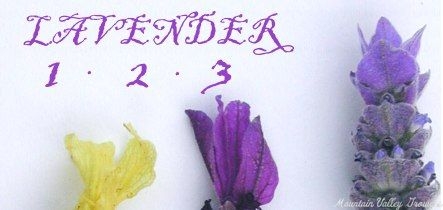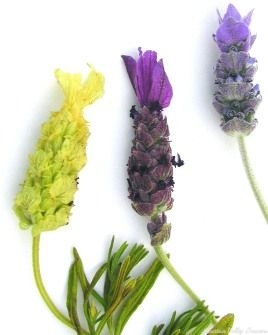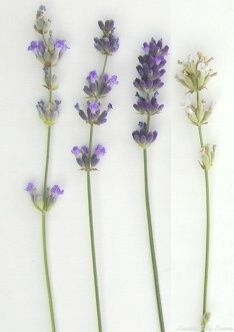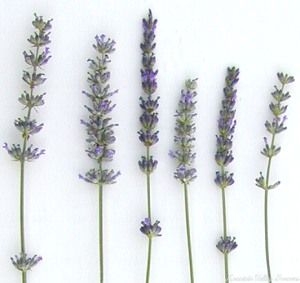Choosing, Growing and Using Lavender

Lavender is an herb most personal. One person’s favorite may be way down on someone else’s list. Recently, we planted a new trial bed with about 15 kinds of this sweet smelling sustenance. Now in its third spring, this sample garden has served to remind us of each plant’s individual characteristics; subtleties that we tend to forget when we grow them in long massive rows. Our new trial garden was laid out with three of each kind of Lavender planted in a triangle, with each plant situated about two feet apart. Planted this way, it is easy to tell which ones grow quickly or are biggert and should have been planted further apart; and which ones grow slower and are smaller and, for quicker turn around, should have been planted closer together. We can see which ones are suited for which landscape need, which ones flower longer (or sooner or later), and which ones smell heavenly (or like a hospital). All in all a very practical way to learn about lavender.
Spring to Fall: Lavenders have it all
Yes, there is a Lavender blooming almost all the time in our gardens. This is easier to achieve in a Zone 8 garden like ours, but even those in Zone 5 can enjoy the fragrance of Lavender throughout much of the growing season.
THE NON-ENGLISH LAVENDERS

When most of us think of lavender it is the English varieties (botanically known as Lavandula angustifolia) that infiltrate our senses. But, gardeners in Zones 8 to 10 get a bit of a Lavender bloom head start with these other species of Lavenders which include French, Pinnata, Richard Gray, Spanish and Kew Red Spanish, Sweet, and Yellow Lavender. These Lavenders start blooming early to mid-spring. Spanish and Yellow Lavenders finish up after four or five weeks, while the others bloom for a bit longer.
All of these do best with a good pruning about four or five weeks into the bloom cycle, which discourages these large Lavender bushes from becoming untidy and, for some, encouraging a second sweep of blooms. The variation in fragrance, size, color, texture, and flower heads among the Lavenders in this group make it a truly exciting group of plants.
French Lavender has the more traditional gray leaves but with serrated edges. A large, fast growing shrub that is sometimes referred to as everblooming Lavender, French Lavender does best when kept at no more than three feet, including blooms. The large, blocky flower heads can be dried if picked before any of the little flowers turn brown.
Pinnata Lavender is a zone 10 lavender that grows fast and can be grown as an annual. It has really long flower wands, fern like leaves and oddly twisted spiral shaped flowers.
Richard Gray Lavender is one of the best lavenders for a small boarder. Absolutely gorgeous silver (much more silver than most lavenders) and deep dark purple flowers make this one of our favorites.
Spanish Lavender, with its dark purple, pineapple-shaped flower heads and dark green leaves, makes a beautiful water saving garden when planted with Orchid Rockrose and Golden Garden Sage. Spanish Lavender grows low and wide and may layer its stems and root, allowing one plant to cover a lot of ground. Spanish Lavender is sometimes referred to as French Lavender. Since it grows wild in France, this is understandable but French is more commonly used with L. dentata.
Kew Red Spanish Lavender is a smaller version of Spanish Lavender with medium pink flowers and dark pink flower bracts. It looks great planted with other pinks that bloom around Easter like Orchid Rockrose or Pink Gaura
Sweet Lavender is Lavender in the extreme. The greenest leaves, the greatest size, the fastest growth, and the longest flower wands are all great reasons for having this Lavender in the garden. Plant a large triangle of Sweet Lavender in the middle of a garden and surround it with Chocolate Scented Daisies for a visual and fragrant impact.
Yellow Lavender also has a pineapple-shaped flower head similar to Spanish Lavender but the colorful top bracts are a lemon chiffon color. The yellow-green leaves are pungently scented and their color makes them a good foil for gray Lavenders. Since this Lavender grows tall and wide, it can be planted at the back of a row of Lavandula angustifolias or L. x intermedias.
THE ENGLISH LAVENDERS

Our English Lavenders (Lavandula angustifolias), include, Munstead, Hidcote, Jean Davis, Sarah, Royal Purple and Vera. These flower in mid to late spring and are usually finished by late spring or early summer. Beautiful when flowering and, after pruning, remain a compact gray ball or hedge with exotically fragrant leaves. Cooler summer climates may have extended bloom periods, but where summers are hot, these stop blooming as the heat increases. These Lavenders are hardy to Zone 5 but, like all Lavenders, will not tolerate poor drainage or high humidity.
Hidcote English Lavender is famous for its dark purple flower. Hidcote English Lavender prefers a cooler climate than our semi-arid summer can provide and we consistently have problems with it dying during hot months. More suited to areas with temperatures in the 80’s to low 90’s this lavender is a true show stopper when planted in mass.
Jean Davis English Lavender has a pastel pink flower. Perhaps the sweetest tasting lavender flower sets Jean Davis apart from other Lavenders and makes it a must have for cooking. Munstead’s flavor is a close second and, since it is easier to grow, it was chosen as an addition to our Edible Flower Herb Garden Six Pack.
Munstead English Lavender is named for Munstead Woods, the home of famous garden designer Gertrude Jekyll. Munstead Lavender with its lilac flower stems looks great planted with Yellow or White Roses.
Royal Purple English Lavender is a darker purple flowered lavender that is very fragrant and makes a nice smaller hedge. This variety was bred in the 1940’s for drying and tends to hold onto more of the purple color from the flowers.
Sachet English Lavender has become one of our favorite English Lavenders. It has a medium purple flower and flowers longer for us here in our heat. Called Sachet for its heady, sweetly scented flowers, Sarah English Lavender is one of many lesser-known L. angustifolias. A very small plant with short flower spikes and small, yet showy dark purple flowers; it is very suited to window boxes and container growing.
Vera Lavender or Lavender Vera is thought to be the true English Lavender. Also called True Lavender or Fine Lavender, the best quality oil comes from plants grown at altitudes between 2500 and 4500 feet on the sides of mountains in central Europe. It is thought to be the best Lavender for medicinal and aromatherapy purposes.
THE LAVANDINS

The English Lavender Hybrids, sometimes referred to as Lavandins; come in third in the bloom cycle, starting just as the the English Lavenders are finishing, and continue to mid-summer. These are the workhorses of Lavender. They do it all: bloom lots, grow just the right size, and smell like a million bucks. Provence and Grosso are the best known of these, but there are many others, including Abriali, Edelweiss, Grappenhall, Hidcote Giant, and White Grosso. These are the Lavenders we use to line the drive or to border the garden.
The botanical name for the Lavandins is Lavandula x intermedia. The x means it is a cross with two plants. In this case, the cross is between L. angustifolia and L. latifolia. The intermedia means that these crossed plants have qualities of both parents, or it is intermediate between them.
Lavandins have long gray leaves, twice or more the size of L. angustifolias. They also grow much larger and faster and are more adept at dealing with heat. For this reason, they are widly grown for oil production that is mainly used in commercial applications like shampoo or laundry soap.
Abriali Lavender is one of the older Lavandins. Also beautifully colored, it is a little shorter than Grosso and was used for oil production before Grosso was developed.
Edelweiss Lavender has a very fragrant, swan white flower and grows a bit shorter and a bit tighter than White Grosso Lavender.
Grosso Lavender is cultivated for oil used mainly in the cosmetic industry. It makes great Lavender bouquets and wands. Grosso Lavender has beautiful purple calyxes instead of the normal green calyx that most lavenders have. The result is a very dark purple flower.
White Grosso Lavender is a must have for the garden and for the vase. The pure white blooms complement the purples of other lavenders and they stay white when dried.
Grappenhall Lavender is a tall, long-leaved Lavender with a slender bloom and a medium purple flower. Because the leaves are longer this plant has the energy to grow quickly and in larger proportions.
Hidcote Giant Lavender has medium purple flowers that are close together. It is a striking plant in the landscape.
Provence Lavender has a long, slender flower wand that is useful for dried bud collecting. The buds come cleanly and easily away from the stalk. Like Hidcote Giant it has a medium purple flower.
Silver Edged Lavender has beautiful variegated leaves that are green with a silvery border around the outside. Any way you look at them, these lavenders are luscious, long stemmed, aromatic necessities.
PLANTING, GROWING, PRUNING, HARVESTING AND USING
Most lavenders are started from cuttings taken from Mother plants. This is both fast and accurate, producing an exact replica of the original plant.
Starting Lavender from seeds sounds like a great inexpensive way to get all the lavender you desire but it can have some major drawbacks. The first obstacle is finding the seeds. Even though Spanish, Yellow, and other species Lavenders can be started from seeds, it is usually only the Lavandula angustifolias—Hidcote, Vera, and Munstead— that are available as seeds.
The second drawback is what we call ‘low and slow’ germination. Lavender seeds have a short shelf life, and therefore the germination rate (how many seeds out of 100 come up) is usually pretty low. They can also take a long time to sprout (two weeks or more) and this invites fungus to the seed tray, often causing the seed to rot before it can sprout.
Seeds benefit from light, so cover lightly when sowing. The germination temperature should be around 70 degrees and spring seeding is more successful than fall seeding. Those seeds that do sprout will take one to three months before they have enough roots and top growth to allow successful transplanting. Adding fertilizer to the sterile medium used in the seed tray can help the little plants get off to a better start, but it can also invite fungus in cool, humid situations.
The third disadvantage is the time it takes for the seedlings to get to a good size. After they are transplanted into small pots, the plants will be about three inches tall and have a single stem. It will take another three months or more to make a plant substantial enough to transplant to a larger pot or to the garden.
The fourth inconvenience is the difference factor. Because little care has been taken over the years to insure that the seeds have not crossed with each other, the plants will be varying shades of color. They might also vary some in height and width and will not be the exact plant you may be expecting.
This was the surprise our customer had when she tried to grow her own. The perfect hedge of Hidcote Lavender she had dreamed about and worked so hard to grow the plants for turned out to be more like a cottage garden: still beautiful, but irregular in form and color. She was glad to finally find plants that are true to name.
And, lastly, the most popular Lavenders (the Lavandula x intermedias; sometimes called Lavandins), either do not make seeds or the seeds are sterile, so you will never see a seed packet of these.
The most important factor for Lavender to grow well is perfect drainage in the soil. Soggy areas should definitely be avoided. Incorporate organic matter if necessary to make a loose friable soil. Compost is the best amendment because it is fertile and has uneven particle sizes. Uneven particles in the soil create better air spaces and give the roots better anchors to attach themselves to. Check the soil’s pH (potential hydrogen) to make sure it falls somewhere between 6.5 and 7.5. If the soil is too acidic the Lavender will not thrive. If the soil is too alkaline, the nutrients are ‘tied’ up in the soil and the plant cannot use them. Yellowed growth can be indicative of a soil that is out of balance. Adding compost can help to balance the pH.
If you are going to plant a hedge or a massive amount of Lavender, make sure the ground is cleared of weeds. Solarization works to remove not only tenacious weeds, but also kills weed seeds. Small Lavender plants cannot compete with aggressive weeds, and weeding after they are planted can be a huge hassle. Weeding often becomes such a chore that Lavenders are overrun and eventually die in a neglected field.
Mulching with a small particle mulch or compost after planting helps with the weed control, but avoid mulching right up to the stem of the small plant. Instead, leave a collar about two inches wide around the plant.
If you are in hot, humid areas, try planting Lavenders in a raised bed or on a mound. Leave plenty of room between plants for air circulation. Lavenders are not ideally suited to heat and humidity, so be prepared for problems, such as fungal disease and rot.
For ultimate show, space plants according to their height measurement. For example, a Grappenhall Lavender is listed at 3 to 4 feet. By spacing these 3 or 4 feet apart, the effect when the plant is blooming is spectacular. If it is more important that the plant make a tight row or hedge, then plant closer together.
If planting in pots, make sure to repot every spring into a larger container with fresh soil to allow the plant to continue to mature and to provide as many flowers as possible. A good, coarse, sterile potting soil with organic fertilizer mixed in works best.
In the ground or in a pot, full sun is a must. If the garden is crowded, plant near a south-facing wall. Even the Lavender at the north end of the row will be shorter and bloom later. In hot areas, some late afternoon shade can be tolerated without sacrificing the glorious mounded shape and rising pincushion effect of the flower wands.
Lavender in the field rarely needs fertilizer, especially if compost is applied as a mulch. More often, problems arise because the soil is not healthy. Avoid chemicals in pesticides, herbicides, and fertilizers that kill or starve the beneficial organisms in the soil.
In arid regions with no summer water, irrigation will be necessary for the survival of the plants. While Lavender is extremely drought resistant once established, it grows larger and produces more blooms with regular watering. This means that when it is dry, water it. While this may sound obvious, it is important to let it dry out a bit before soaking it again. In humid areas, this can be difficult and the excess moisture often causes death.
Zones 8 and up can plant Lavender in spring and fall, but other zones are better off with a spring planting after the last frost. If fall planting is to be tried, plant at least two months before the first frost. It is important that the plant actually make good root development into the native soil before severe winter weather occurs. Lavender grows slowly in the fall and often plants are not sufficiently established to get through winter rains and cold.
It takes about three years for a Lavender to reach full size. Plants should be pruned every year immediately after bloom. Pruning should not be confused with harvesting. Pruning is necessary to extend the life of the plant. Lavender flower wand stems are usually a bright green while Lavender leaves are gray. Cut back not only the flower stem, but also about a third of the gray-leaved stems as well. If the plant has been neglected, it can be cut back further, but avoid pruning back so far that only woody stems with no leaves are showing. A plant pruned into the wood may push out latent (sleeping) buds or it may die.
Harvesting Lavender is one of the most enjoyable pleasures any gardener can have. Lavender flower heads look gray before the flowers open. They are devoid of most color and it is easy to become impatient waiting for them to burst into bloom. Once the color is bright and vivid, that is the time to start cutting. Cut the flower stems during the cool of the morning after the dew has dried. In humid areas, try to cut on dry days.
For use in arrangements, it is easiest to arrange the Lavender while it is fresh and supple. This can be done in the garden if it is not too hot. If the weather is very warm (even in the morning), take a bucket of water, filled about a quarter of the way, and submerge the cut end of the stems into the bucket. Remember that the plant cools itself by releasing its fragrant oils, so the more heat they are exposed to the less oil, and fragrance, for you. Arrange out of direct sun as soon as possible. Stand them in a dry vase and the fresh flowers become dry ones. Or use fresh in small groups as an accent for a fresh herbal wreath.
If the flowers are to be used later, dry in small groups by tying with a twist tie and hanging in a dark dry place or individually by spreading them on a screen and drying out of the sun. Once dry, the buds can also be stripped and used as bulk for potpourri, sachet, or even cooking. Some Lavenders hold their buds better than others. Grosso Lavender is preferred for wand making and dried arrangements because the flowers stay on the stem better. This is something to consider if your primary focus is to REMOVE the dried buds for bulk use, such as potpourri. Provence Lavender is more suited to this because the buds release easily from the calyx (too easily for dried bouquets or wands).
The further along in the bloom cycle, the more fragile the flowers seem to be. Actually, what happens is that the little flowers fall out and what is left is the calyx and any unopened buds. Most Lavenders bloom for about 5 weeks, so do a little experiment in your garden to see when the harvest is best for your needs.
If you are harvesting a lot of Lavender, try this tip from the Lavender experts at Purple Mountain Majesty.
Hand harvest by sticking your left thumb in the flowers to be cut while simultaneously hooking the flower stalks in front and below your left hand with a Chinese sickle. You pull and cut the first bunch into your left hand with one motion. The process is repeated without removing the cut material until you have completely cut counterclockwise around the plant essentially twisting the cut stalks around the center uncut stalks as you go. This keeps even the largest bundles under control because the whole bundle winds around the center uncut stalks creating enough friction to keep everything together and eventually captured under your left arm. If the bundle is too big for your grip, then it is kept from falling apart by your thumb and the center stalks, which you cut in a final cutting motion starting with a reversed sickle in front of your left leg and vectoring in a direction that is away from the harvester.
Lavender smells like it should taste wonderful, but the taste of most Lavenders is a little like turpentine. The flavor is not one that can be easily defined nor is it one most people like right away. It is like a fine wine with many subtleties. Both fresh and dried flowers and leaves are used in culinary preparations. Recipes using Lavender are generally on the sweet side (like in our Lavender Sorbet recipe below) but Lavender can be used to replace Rosemary and other strong tasting herbs. Or, it can be blended with other herbs, as in herbs de Provence. This mix, used in many savory dishes, often finds dried Lavender leaves and flowers mixed with other members of the mint family, like Rosemary, Sage, Oregano, Thyme and Mint.
Used not only to make life smell richer and more tolerable, but also as a medicinal relief for ailments from headaches to insomnia, Lavender oil has always been a prize. In times past, most Lavender oil was distilled from the angustifolia species of Lavandula.
Often referred to as English Lavenders, these Lavenders are native to the western half of the Mediterranean. Now cultivated in many countries, it was thought the finest Lavender grew in England and thus the common name English Lavender evolved and is still the name most folks use when referring to Lavender products.
Because these Lavandula angustifolias are small, and because they are pretty particular about where they grow, it takes a lot of plants to produce one ton of oil; so most Lavender oil now comes from the Lavandins. These are hybrid Lavenders that have the English Lavender as one parent and the Spike Lavender (Lavandula latifolia) as another. These Lavenders tolerate a more diverse climate, and, since they are larger, produce more oil per acre. This oil, while less expensive, is not as good for medicinal purposes as English Lavender oil, but it is widely used in the perfume and craft industries.
And, when you hear the term French Lavender Oil, don’t be confused. The French nom de plume refers to where it is grown and not which plant it is from. French Lavender oil is really English Lavender oil produced in France!
Many of our lavenders are often available in plug trays. These trays hold 128 of all the same plant. They are a great low cost way to fill a lot of space. Each cell is 3/4 of inch an inch. Check here to see which Lavender Plug Tray are available.
Lavender Sorbet
A summer treat!
- 3 cups water
- 1/2 cup sugar
- 9-10 stem heads of fresh lavender flowers (or 2 tablespoons of dried lavender)
- Freshly squeezed juice of 1 lemon
If using fresh lavender:
With thumb and forefinger, pull the flowers from the stems (discarding stems). If using dried lavender you won’t need this step.
Combine lavender flowers and sugar in a food processor and pulverize completely, about 1 minute. Bring the water to a boil, remove pan from heat and add the sugar/lavender mixture, stirring to dissolve sugar. Cover with a lid and let cool for at least 30 minutes. Strain out flowers through a sieve, pressing flowers to get out any remaining liquid. Add the lemon juice and chill in the refrigerator for at least 2 hours, then freeze in sorbet or ice cream mixer.
(From Fabulous Herb & Flower Sorbets by Jim Long)
